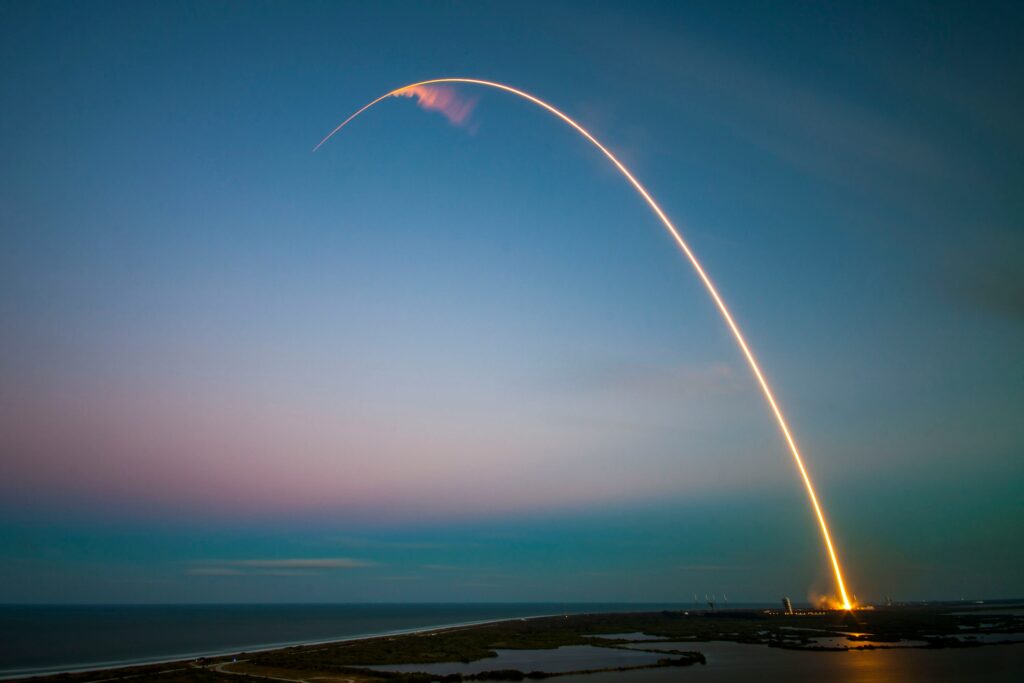SpaceX successfully launched a Falcon 9 rocket from Kennedy Space Center on Saturday morning, carrying 21 new Starlink satellites into low Earth orbit. Among the satellites, 13 are equipped with Direct to Cell technology designed to enhance mobile coverage in remote and signal-dead areas. This launch is part of SpaceX’s ongoing effort to create a global satellite network capable of providing reliable internet in underserved regions around the world.
SpaceX Expands Starlink’s Global Reach
On Saturday, SpaceX’s Falcon 9 rocket lifted off from Kennedy Space Center, deploying 21 Starlink satellites into orbit about an hour after takeoff. This marks another significant step in SpaceX’s ambitious plan to build a global satellite network. The primary goal of Starlink is to provide high-speed internet to remote and underserved areas, including those where traditional ground-based infrastructure is unavailable.
Among the 21 satellites launched, 13 feature new Direct to Cell technology. This innovation is designed to eliminate mobile dead zones by allowing users in areas without cell tower coverage to access mobile networks via satellite. SpaceX’s plan is to ensure that these regions are no longer cut off from communication services.
The Rapid Growth of Starlink’s Network
SpaceX continues to expand Starlink’s satellite fleet, which is now thousands strong. The rapid deployment of satellites is helping extend internet connectivity to areas previously underserved by traditional services. With each launch, SpaceX enhances the network’s speed and reliability, especially in rural, mountainous, or oceanic areas where traditional broadband services struggle to reach.
Starlink’s satellite network is already operational in over 100 countries, providing fast and stable internet access to millions of users worldwide. The ability to connect remote locations like deserts, forests, and islands makes Starlink an essential tool for global connectivity. As more satellites are launched, SpaceX aims to improve speeds and offer a stronger signal for users in even the most difficult-to-reach places.
Elon Musk’s Vision for a Connected World
Elon Musk, the CEO of SpaceX, has been instrumental in pushing the Starlink project forward. The initiative reflects his vision to connect the world by creating a vast satellite network that delivers high-speed internet anywhere on Earth. Musk’s ambition extends beyond just internet access; he envisions Starlink as a critical component for future technological advancements, particularly for mobile and rural communication solutions.
Starlink’s growing reach aligns with Musk’s broader goals of expanding humanity’s presence in space. The ongoing expansion of the satellite constellation is helping make space-based internet a viable alternative to terrestrial services, especially in areas with inadequate infrastructure. Every launch brings SpaceX closer to its goal of achieving global connectivity.
Concerns About Space Traffic and Environmental Impact
While SpaceX’s Starlink network is making significant progress in global connectivity, the rapid expansion of satellites has raised concerns among scientists and environmentalists. One of the biggest issues is the rising amount of space debris in low Earth orbit, which could lead to dangerous collisions between satellites and other space objects.
Experts also worry about the environmental impact of frequent rocket launches. They point to the potential for increased atmospheric pollution, as well as the potential consequences of having thousands of satellites orbiting Earth. Additionally, astronomers have raised alarms over the brightness of Starlink satellites, which can interfere with ground-based observations of space.
Critics argue that the growing number of satellites may create challenges for future space exploration. However, SpaceX maintains that it follows debris mitigation guidelines and tracks the movement of its satellites to avoid collisions in orbit. Despite these assurances, environmentalists and experts are calling for stronger global regulations on satellite deployment to ensure the safety and sustainability of space operations.
The Future of Space-Based Internet
As SpaceX continues to expand Starlink’s satellite network, the company is set to transform the landscape of global internet access. The promise of providing fast, reliable internet to even the most remote locations is already changing how people live and work in underserved regions.
However, as the number of satellites grows, balancing innovation with environmental concerns will be crucial. SpaceX’s commitment to tracking satellites and avoiding debris will be tested as more launches take place. International cooperation and regulation will likely become key factors in managing the future of space-based internet, ensuring that advancements in connectivity do not come at the cost of space safety.
In the coming years, Starlink’s expanding network will offer even greater coverage, speed, and reliability for users around the world. As SpaceX continues to launch new satellites, the company is set to play a pivotal role in the future of global internet connectivity.
